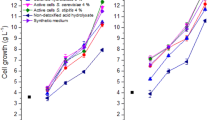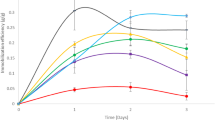Abstract
Chemical reagents used by the textile industry are very diverse in their composition, ranging from inorganic compounds to polymeric compounds. Strong color is the most notable characteristic of textile effluents, and a large number of processes have been employed for color removal. In recent years, attention has been directed toward various natural solid materials that are able to remove pollutants from contaminated water at low cost, such as sugarcane bagasse. Cell immobilization has emerged as an alternative that offers many advantages in the biodegradation process, including the reuse of immobilized cells and high mechanical strength, which enables metabolic processes to occur under adverse conditions of pH, sterility, and agitation. Support treatment also increases the number of charges on the surface, thereby facilitating cell immobilization processes through adsorption and ionic bonds. Polyethyleneimine (PEI) is a polycationic compound known to have a positive effect on enzyme activity and stability. The aim of the present study was to investigate a low-cost alternative for the biodegradation and bioremediation of textile dyes, analyzing Saccharomyces cerevisiae immobilization in activated bagasse for the promotion of Acid Black 48 dye biodegradation in an aqueous solution. A 1 % concentration of a S. cerevisiae suspension was evaluated to determine cell immobilization rates. Once immobilization was established, biodegradation assays with free and immobilized yeast in PEI-treated sugarcane bagasse were evaluated for 240 h using UV–vis spectrophotometry. The analysis revealed significant relative absorbance values, indicating the occurrence of biodegradation in both treatments. Therefore, S. cerevisiae immobilized in sugarcane bagasse is very attractive for use in biodegradation processes for the treatment of textile effluents.







Similar content being viewed by others
References
Amin, N. K. (2008). Removal of reactive dye form aqueous solutions by adsorption onto activated carbons prepared from sugarcane bagasse pith. Desalination, 223, 152–161.
Barreto, J. W., Bernardino, N. D., & Afonso, R. (2011). Biodegradação de uma mistura de corantes têxteis usando o fungo Ganoderma sp: um estudo cinético. Química Nova, 34(4), 568–572.
Chacko, J. T., & Subramaniam, K. (2011). Enzymatic degradation of azo dyes—a review. International Journal of Environmental Sciences, 1(6), 1250–1260.
Covizzi, L. G., Giese, E. C., & Dekker, R. F. H. (2007). Imobilização de células microbianas e suas aplicações biotecnológicas. Semina: Technology Experimental, 28(2), 143–160.
Daneshvar, N., Rabbani, M., Modirshahla, N., & Behnajady, M. A. (2004). Critical effect of hydrogen peroxide concentration in photochemical oxidative degradation of C.I. Acid Red 27 (AR27). Chemosphere, 56(10), 895–900.
Daneshvar, N., Khataee, A. R., Rasoulifard, M. H., & Pourhassan, M. (2007). Biodegradation of dye solution containing Malachite Green: optimization of effective parameters using Taguchi method. Journal of Hazardous Materials, 143, 214–219.
Glenn, J. K., & Gold, M. H. (1983). Decolorization of several polymeric dyes by the lignin-degrading basidiomycete Phanerochaete chrysosporium. Applied and Environmental Microbiology, 45(6), 1741–1747.
Guaratini, C. C. I., & Zanoni, M. V. (2000). Corantes têxteis. Quim Nova, 23(1), 71–78.
Homagai, P. L., Ghimire, K. N., & Inoue, K. (2010). Adsorption behavior of heavy metals onto chemically modified sugarcane bagasse. Desalination, 101, 2067–2069.
Kunz, A., Peralta-Zamora, P., Moraes, S. G., & Durán, N. (2002). Novas Tendências no Tratamento de Eflfuentes Têxteis. Quimica Nova, 25(1), 78–82.
Leal, C. C. A., Rossiter Sa Da Rocha, O., Duarte, M. M. M. B., Dantas, R. F., Da Motta, M., Medeiros De Lima, N. M., & Da Silva, V. L. (2010). Evaluation of the adsorption process of remazol black B dye in liquid effluents by green coconut mesocarp. Afinidad, 66(546), 136–142.
Lu, X., & Liu, R. (2010). Treatment of azo dye-containing wastewater using integrated processes. In H. A. Erkut (Ed.), Biodegradation of azo dyes (pp. 133–155). Heidelberg: Springer.
Martin, M. (1998). Bioconversion of waste materials to industrial products (p. 556). London: Blackie Academic and Professional.
Martín-Lara, M. A., Rico, I. L. R., Vicente, I. C. A., García, G. B., & Hoces, M. C. (2006). Modification of the sorptive characteristics of sugarcane bagasse for removing lead from aqueous solutions. Desalination, 256, 58–63.
Mitter, E. K., Santos, G. C., Almeida, E. J. R., Morão, L. G., Rodrigues, H. D. P., & Corso, C. R. (2012). Analysis of Acid Alizarin Violet N dye removal using sugarcane bagasse as adsorbent. Water Air Soil Pollution, 223, 1–6.
Ogugbue, C. J., & Sawidis, T. (2011). Bioremediation and detoxification of synthetic wastewater containing triarylmethane dyes by Aeromonas hydrophila isolated from industrial effluents. Biotechnology Research International, 2011, 1–11.
Rachakornkij, M., Ruangchuaya, S., & Teachakulwiroj, S. (2004). Removal of reactive dyes from aqueous solution using bagasse fly ash. Indian Journal of Science and Technology, 26(1), 13–24.
Saad, S. A., Isa, K., & Bahari, R. (2010). Chemically modified sugarcane bagasse as a potentially low-cost biosorbent for dye removal. Desalination, 264, 123–128.
Solmaz, S. K. A., Birgül, A., Üstün, G. E., & Tasdemir, Y. (2006). Colour and COD removal from textile effluent by coagulation and advanced oxidation processes. Coloration Technology, 122, 102–109.
Suksombat, W. (2004). Comparison of different alkali treatment of bagasse and rice straw. Asian-Australian Journal of Animal Sciences, 17(10), 1430–1433.
Sumbu, Z. L., Thonart, P., & Bechet, J. (1983). Action of patulin on a yeast. Applied Environment Microbiology, 45(1), 110–115.
Tazhibaeva, S. M., Musabekov, K. B., Orazymbetova, A. B., & Zhubanova, A. A. (2003). Surface properties of yeast cells. Colloid Journal, 65(1), 122–124.
Teramoto, M., Nishibue, H., Ogawa, H., Kozono, H., Morita, K., & Matsuyama, H. (1996). Effect of addition of water-soluble cationic polymers on thermal stability and activity of glucose dehydrogenase. Colloid Surface B, 7, 165–171.
Vitor, V., & Corso, C. R. (2008). Decolorization of textile dye by Candida albicans isolated from industrial effluents. Journal of Industrial Microbiology and Biotechnology, 35(11), 1353–1357.
Author information
Authors and Affiliations
Corresponding author
Rights and permissions
About this article
Cite this article
Mitter, E.K., Corso, C.R. Acid Dye Biodegradation Using Saccharomyces cerevisiae Immobilized with Polyethyleneimine-Treated Sugarcane Bagasse. Water Air Soil Pollut 224, 1391 (2013). https://doi.org/10.1007/s11270-012-1391-2
Received:
Accepted:
Published:
DOI: https://doi.org/10.1007/s11270-012-1391-2




